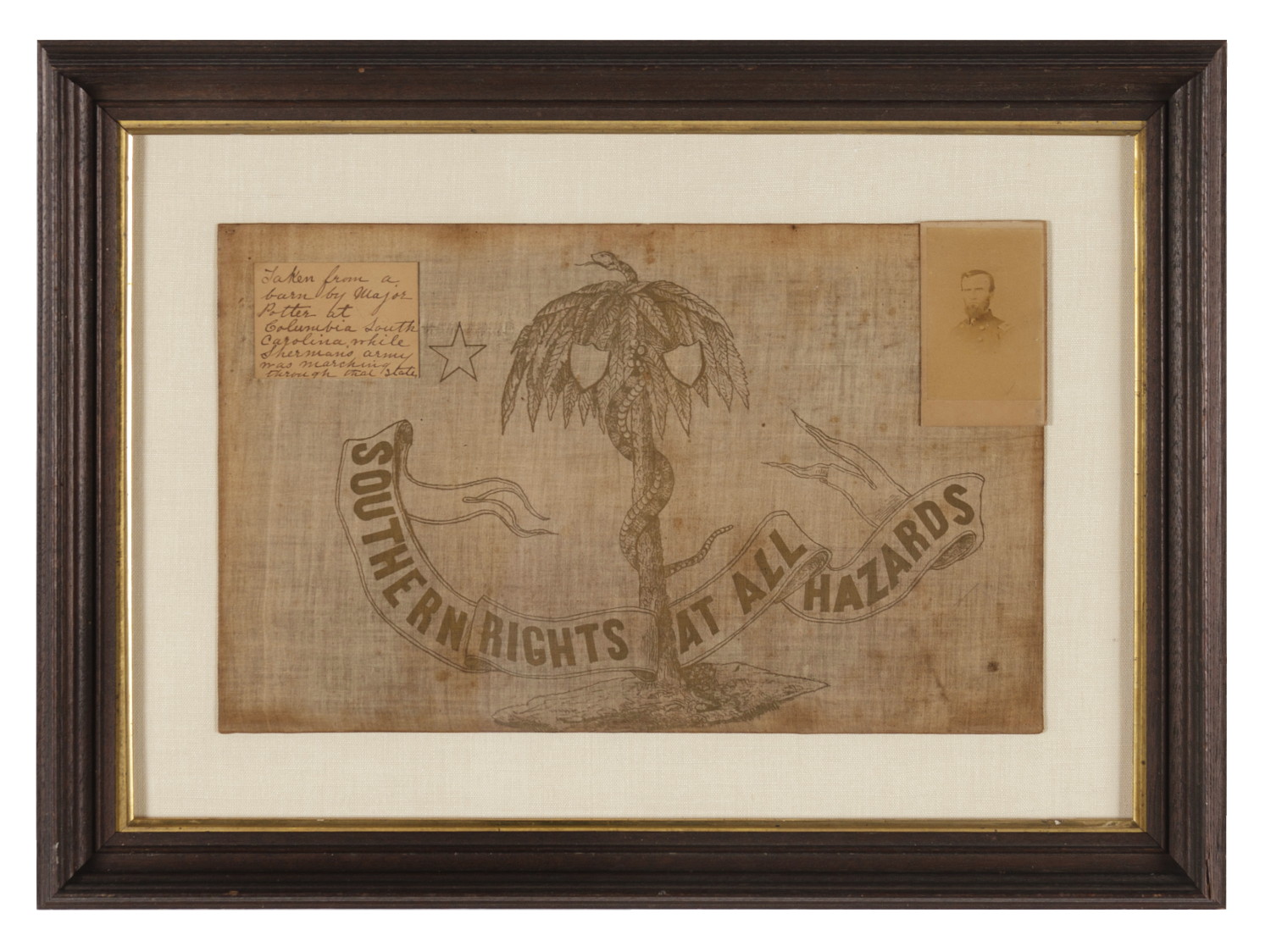
| |
EXCEPTIONALLY RARE, CONFEDERATE, SOUTH CAROLINA PARADE FLAG TEXTILE, TAKEN BY A UNION OFFICER WHO ACCOMPANIED SHERMAN ON HIS MARCH TO THE SEA, SHORTLY FOLLOWING THAT CAMPAIGN IN 1865 |
|
| Available: |
Sold |
| Frame Size (H x L): |
17" x 23" |
| Flag Size (H x L): |
10" x 16" |
|
| Description....: |
|
Following the Confederate attack on Fort Sumter that initiated the Civil War, printed parade flags were produced in the North for the first time in significant numbers. By contrast, however, patriotic textiles proclaiming sympathies for the Southern cause were not produced in the South. That's what makes this unusual textile, printed on cotton chintz, so very rare. I have never before seen this variety, nor any other in a similar style. Featured is a palmetto tree, wrapped by a rattlesnake, with an arched streamer overhead that boldly reads "Southern Rights at all Hazards".
A descriptive note is attached, written in a period, 19th century hand, that reads as follows: "Taken from a barn by Major Potter at Columbia South Carolina while Sherman's Army was marching through that state". A CDV card picturing Major Potter is also attached. On the back of the board on which the textile, note, and CDV were attached and framed, another note, also in an early hand, reads: "My uncle Dr Major Potter who went with Sherman on his march to the sea."
"Sherman's March to the Sea" was one of the most famous and brutally destructive events of the war, as the general forced a hard march through the heart of Georgia, from Atlanta to Savannah, burning and pillaging, in an effort to cause a level of fear and despair that was hoped to force surrender.
Immediately following that campaign, Sherman embarked on another through the Carolinas to end the war. Sherman captured the state capital of Columbia, South Carolina, on February 17, 1865. Fires began that night and by next morning most of the central city was destroyed. The burning of Columbia has engendered controversy ever since, with some claiming the fires were accidental, others a deliberate act of vengeance, and still others that the retreating Confederates burned bales of cotton on their way out of town.
Columbia's First Baptist Church hosted the South Carolina Secession Convention on December 17, 1860, with delegates selected a month earlier at Secession Hill. The delegates drafted a resolution in favor of secession without dissent, 159-0, creating the short-lived Republic of South Carolina. Because South Carolina was the first state to secede, this was the birth of the secession. Columbia's location afterwards made it an ideal spot for other conventions and meetings within the Confederacy. It also served as an important supply center for the Confederate Army.
Legend has it that Columbia's First Baptist Church narrowly missed being torched during Sherman's occupation. As the story goes, the soldiers marched to the church and asked the groundskeeper if he could direct them to the location of the church where the declaration of secession was signed. The loyal groundskeeper directed the men to another church, a Methodist church located nearby and the historic landmark thus avoided destruction.
It's utterly remarkable that this textile was collected during Sherman's campaign and has survived for the nearly 150 years that have since elapsed. Given the political importance of the location in which it was found, it seems logical that it was produced for local use. Further, it seems likely that it may have been made to celebrate the day on which South Carolina became the first state to secede. |
|
|
|
| Collector Level: |
Flags for the truest Patriots. My best offerings |
|
| Flag Type: |
|
|
| Star Count: |
|
|
| Earliest Date of Origin: |
1860 |
|
| Latest Date of Origin: |
1861 |
|
| State/Affiliation: |
South Carolina |
|
| War Association: |
1861-1865 Civil War |
|
| Price: |
SOLD |
|
| |
Views: 2100 |
|
|
|

